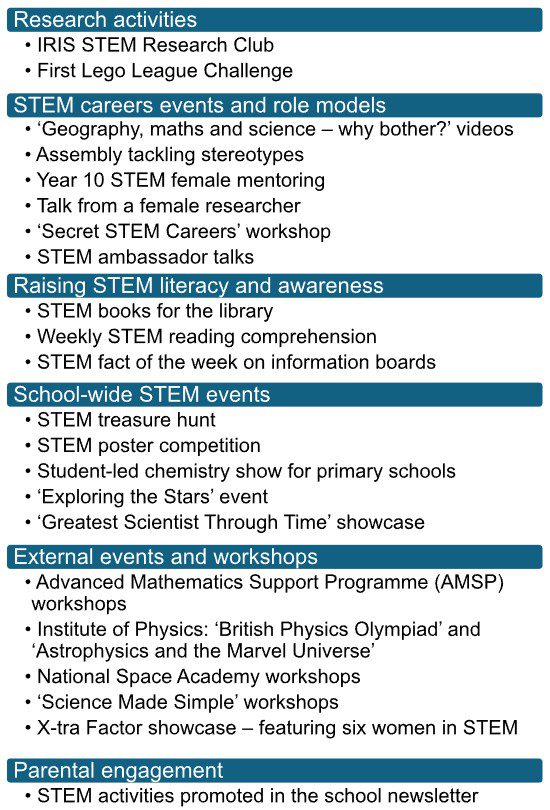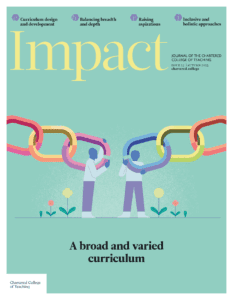An evidence-based framework to develop STEM delivery in schools

ALISON ROUNCEFIELD-SWALES, GEORGIE LOTT AND LYDIA SEARLE, THE INSTITUTE FOR RESEARCH IN SCHOOLS, UK
Introduction
The Institute for Research in Schools (IRIS) collaborates with schools and colleges to engage students in authentic research projects. We understand the benefits of participating in scientific research and we advocate for every student benefiting from engaging in research. However, we acknowledge the difficulties that schools encounter in providing extracurricular opportunities. To address these challenges, IRIS created the Research and Innovation (R&I) Framework to help schools to integrate R&I into their science, technology, engineering and mathematics (STEM) culture and to build students’ science capital (Archer et al., 2015; Moote et al., 2021). The R&I Framework aims to modify how STEM is approached in schools and increase young people’s involvement by incorporating problem-solving, knowledge acquisition, knowledge creation and career understanding into learning in classrooms and extracurricular activities. The approach recognises that for STEM engagement in schools to have a lasting impact, it must be sustained beyond one-off activities (Archer et al., 2021).
Research and innovation (R&I) is a term widely used to describe the production of new knowledge (research) and using that knowledge to solve problems (innovation). In schools, an R&I approach means students experiencing a more exciting vision of STEM in terms of its real-world applications and impact.
This article examines the key factors that affected the implementation and impact of the R&I Framework project in schools.
The pilot project
IRIS piloted the project with nine schools (although every effort was made to support schools who embarked on the project, two schools were unable to continue due to reasons outside of our control), including schools with high free school meal (FSM) eligibility and low attainment. IRIS provided a small amount of funding to each school and supported schools through an improvement cycle aimed at integrating R&I into STEM for Year 9 students. Throughout the project, IRIS provided tailored resources, training and ongoing support. See Figure 1 for a summary of the process.

Figure 1: Pilot cycle
The study
The study aimed to understand the implementation of the pilot and impact on students, teachers and school STEM culture. IRIS used a quasi-experimental, mixed-methods approach to measure impact, comparing the participating (intervention) schools with a matched (comparator) group of schools (based on factors such as locality and FSM eligibility).
Student surveys
All Year 9 students were invited to participate in a survey to measure their perceptions, experiences and understanding of STEM. Students in intervention schools completed the survey before and after the pilot intervention, with the data creating a baseline for action planning and impact measurement. Similarly, students in comparator schools completed the survey twice without experiencing the intervention. Over 2,300 students completed at least one survey, with the results reviewed in other publications (see https://researchinschools.org/framework).
Interviews and case studies
Interviews were conducted with 120 students and 21 teachers in intervention schools during and at the end of the project to explore their experiences. Pseudonyms have been assigned to all students, teachers and schools.
Example interventions
Impact was created through the cumulative effect. Figure 2 illustrates a year of activity for one school, during which they aimed to expand students’ understanding of STEM, highlight its real-world applications and increase participation, especially among girls.

Figure 2: Elm Grove Academy interventions
The key factors
The study sets the learning about the project within the individual school contexts, to understand reasons behind varying levels of impact. Schools that were grappling with lower standards for student attendance and behaviour often struggled to engage and had corresponding levels of impact. Whereas schools with a vision focused on student engagement, developing the curriculum and fostering aspirations aligned closely with project objectives, enhancing their capacity for implementation. Through the thematic analysis of senior leader and project lead interviews, several key factors were identified that have relevance for those with a role in leading STEM in schools.
Evidence- and data-driven
Schools were encouraged to use evidence and data and respond to their own context. This focus was a critical and highly valued aspect of the project:
I think it’s the right way to go about it, supporting teachers in the schools, providing some ring-fenced funding that is controlled by the teachers, delivering what’s appropriate for our community, having actual face-to-face conversations, getting together with other schools in the local area and having that communication.
Maths teacher, Birchwood
The initial survey results provided schools with insight into their students’ understanding, knowledge and perceptions of STEM, with variances highlighted by sex and Pupil PremiumAdditional funding for publicly funded schools in England to raise the attainment of disadvantaged pupils of all abilities. The schools were then supported to utilise this evidence and their self-assessment to create an actionable plan. Through the project, each school implemented a customised programme of activities specifically targeting disadvantaged and underrepresented groupsThe diversity of research participants should reflect the educational community for whose benefit the research is taking place. When this is not the case, some groups are underrepresented. The benefits of utilising data for action planning are illustrated below:
I think it was really actionable… The self-assessment that we did, we shared with the head of maths, head of science, who were in broad agreement that’s where we currently were. And then what the students said sort of matched that and helped me highlight priority areas… I think we then filtered it down to say actually these would make the most impact.
Maths teacher, Heritage Grove
Our study found that these elements helped project leads to create a compelling narrative to mobilise support from colleagues.
Vision-focused senior leadership
In schools that had a senior leader who was enthusiastic about the project, the project lead received ongoing support, resources and time, which better enabled them to successfully implement their action plan. While the most successful project leads were passionate, broader engagement and sustainability was a challenge without support. Where leadership’s commitment was limited or absent, change was slower and sustainability became a concern.
Our findings indicate that schools with strong leadership support enabled project leads to elevate the profile of STEM R&I throughout the school and establish networks across the curriculum. The schools that were most successful in implementing the project demonstrated a culture that acknowledged the importance of STEM R&I and celebrated their students’ achievements in the field. Our evidence suggests that connection between school priorities and the project aims was critical for success.
We are very aware that we need to build a bit more aspiration and confidence… So, we’re trying to get more take-up of extracurricular, more take-up of leadership opportunities, more take-up of all of these things that aren’t just about what’s going on in the classroom, and this ties in really nicely.
Assistant principal, Maplewood High
Collaboration across the school
By focusing broadly on STEM rather than any individual subject, the project was successful in fostering collaboration across the curriculum. This collaboration was instrumental; in schools that demonstrated enthusiasm for new approaches, the project had a wider impact through the implementation of a broader range of interventions. In some schools, activities were designed with a specific goal of integrating curriculum subjects, reinforcing the cross-cutting, interdisciplinary nature of STEM. Although the project lead held overall responsibility, the support of colleagues contributed to deeper integration of activities, which was viewed as essential for longer-term sustainability:
I think there has been a shift; I’ve been able to get improved staff buy-in from other STEM areas… Staff are emailing me saying, “I talked about this with my class today…” I think some of the staff as well, they never really thought about where their curriculum went before.
Lead practitioner – science, Maplewood High
A community of practice
The continuing professional development (CPD) facilitated by IRIS provided project leads not only with a firm understanding of R&I but also with access to a community of practice from across different schools. These opportunities were seen as valuable for career development, offering a chance to build a supportive network, to share best practice and to explore ways in which to overcome challenges:
Being in a room of people that were all doing the same thing and struggling with the same issues… It was more of a discussion, a sharing; and I think that was what we all needed at that point in time.
Science teacher, Meadowbrook
This community facilitated discussion, promoted the sharing of resources and helped project leads to build relationships with local universities and STEM employers, as well as museums and science centres. This led to a broad range of interventions, as well as lasting relationships, to advance STEM education in the schools:
[The project lead] who’s starting on his journey to developing as a leader in the school, this is [a] really good opportunity for him… Any external support that supports him to do that is obviously really beneficial too.
Assistant principal, Heritage Grove
A supportive project partner
The mentorship and support provided by IRIS to project leads and schools through the project was highly regarded.
[It’s been a] very supportive programme. You know, the touching base with the school… touching base with us all the time and having that communication, that has been excellent.
Director of STEM, Pinecrest
Moreover, the half-termly individual meetings with IRIS served as a significant source of motivation. These sessions offered a platform for professional discussion, which assisted project leads in formulating and executing an evidence-based action plan, as one teacher illustrated:
One of the big things that has helped is having the meetings… Just reflecting on your actions, having that once a month where you can speak about what you’ve done. [IRIS] would suggest and give advice on some good resources that I might not have been aware of.
Science teacher, Meadowbrook
IRIS leveraged relationships with a wide array of STEM education partners, allowing project leads to capitalise on these opportunities. Additionally, IRIS provided bespoke materials and resources, including lesson plans, assembly materials and enrichment day programmes, which were received positively:
Having limited time in school, a lot of things were quite quick and easy to implement with the resources that we got given.
Science teacher, Heritage Grove
Conclusion
These findings underscore significant insights that schools aiming to enhance STEM may wish to consider. Our study found that a range of factors contributed to the project’s success in broadening students’ experiences of STEM, including:
- how schools utilised data
- their approach to implementation
- leadership engagement.
This study emphasises the vital role of school leaders in communicating an evidence-based vision and facilitating collaboration to build a whole-school commitment to and understanding of STEM. It also underlines the complexities of running a project of this nature and the critical importance of professional networks, leadership and school culture in developing innovative approaches to STEM (Padwick et al., 2023).
References
- Archer L, Dawson E, DeWitt J et al. (2015) ‘Science capital’: A conceptual, methodological, and empirical argument for extending Bourdieusian notions of capital beyond the arts. Journal of Research in Science Teaching 52(7): 922–948.
- Archer M, DeWitt J, Davenport C et al. (2021) Going beyond the one-off: How can STEM engagement programmes with young people have real lasting impact? Research for All 5(1): 67–85.
- Moote J, Archer L, DeWitt J et al. (2021) Who has high science capital? An exploration of emerging patterns of science capital among students aged 17/18 in England. Research Papers in Education 36(4): 402–422.
- Padwick A, Dele-Ajayi O, Davenport C et al. (2023) Evaluating a complex and sustained STEM engagement programme through the lens of science capital: Insights from Northeast England. International Journal of STEM Education 10: 33.










